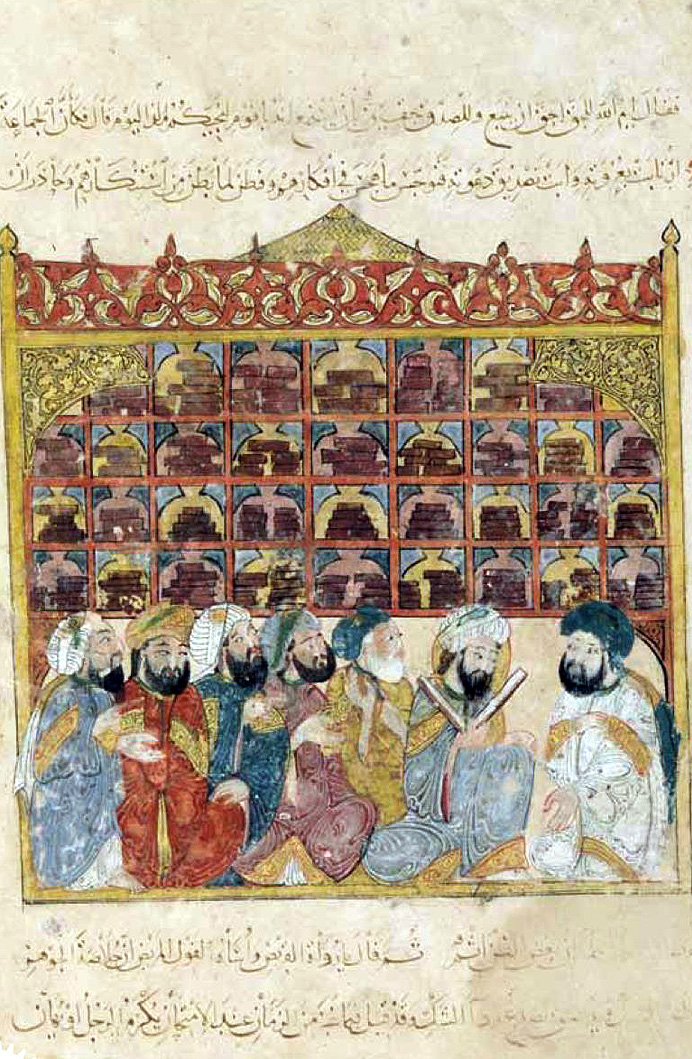Table Of Content

Patronage of the arts and sciences—and, of course, luxury—poured in not only from the caliph but also from the viziers and the other courtiers. Libraries of The Nizamiyyah School were somewhat similar to the House of Wisdom (Bayt al-Hikmah) for the former had had many facilities to offer for students, including student's scholarships and endowment professorship. The Nizamiyyah School libraries and Cairo libraries were reported to have their own binders, administrators, librarians and even guards, they have shared almost all supported by endowments from governments, caliphs and kings. The most interesting thing about the naming of house of wisdom is that all labels signify the same meaning that Bayt al-Hikmah was the place of all knowledge and wisdom to be found. Libraries represented new reality for Muslims and new passion towards the human knowledge and education (Mohammad Ali, 1980). The House of Wisdom (Bayt Al-Hikmah) was seen as one of the leading libraries in Islamic history that appeared during the Golden age of Islam.
Baghdad's House of Wisdom: Uniting East and West to pursue knowledge
The pursuit of knowledge became a dominant feature of Abbasid society, attracting scholars and scientists from all over Europe and the Middle East to take part in this cultural birthing, including Persians and Christians. Scholarly work, particularly translation, became a hugely lucrative career, and some scholars such as Hunayn ibn Ishaq were said to earn the weight in gold of each manuscript they completed. The stars and planets were perceived to influence events on earth and astrology was thus carried out with the greatest attention to detail.Al-Mamun had an astronomical observatory built with the intention of addressing the claims of one of the most dominant voices in the ancient world, Ptolemy. Better-known after its translation as the Almagest, the text initiated a flurry of research and commentary at the House of Wisdom which would last for centuries. It was in 1258 that the accomplishments of the House of Wisdom and the Islamic Golden Age were brought to a cruel halt. During the Mongol invasion of Baghdad under Hulegn, grandson of Genghis Khan, the mosques, libraries, homes and hospitals of the great city were all destroyed.
KBC 2023 Which city was home to the Home of Wisdom, one of the largest libraries in history, that was destroyed in 1258 by the Mongols? - Mapsofindia.com
KBC 2023 Which city was home to the Home of Wisdom, one of the largest libraries in history, that was destroyed in 1258 by the Mongols?.
Posted: Thu, 19 Oct 2023 07:00:00 GMT [source]
Foursquare Heritage Center - McPherson Parsonage
These captivating pieces of art are very photogenic, and it’s a good thing to do with some friends or a date. Our new series, Tsawwar, explores places, people and moments in time through the eyes of photographers and their photos. Ibn al-Haytham built the first camera obscura, making huge discoveries in the areas of optics and visual perception. He was the first to understand and explain the theory of vision, arguing that it occurs in the brain. Figures such as Isaac Newton and Galileo Galilei frequently cited him in their own work.
Sharjah’s House of Wisdom launches new courses in Spanish and Japanese - Gulf News
Sharjah’s House of Wisdom launches new courses in Spanish and Japanese.
Posted: Sat, 05 Aug 2023 07:00:00 GMT [source]
Ancient Egypt
Later, he added numerous other study centres to allow more scholars to pursue their research, and an observatory in 829. Abu Yusuf Ya‘qub ibn Ishaq Al-Kindi was also another historical figure that worked at the House of Wisdom. Al-Kindi is the most famous for being the first person to introduce Aristotle’s philosophy to the Arabic people.

This library was remarkably well organized, having separate rooms for copiers, binders, librarians, and an astronomical observatory. Mahmud Ahmad Derwich has found a suitable architectural planning for Bayt al-Hikmah through his studies on the golden castle constructed by Al-Mansur. The house of wisdom composed of a yard surrounded by halls of two floors from its four sides, it was headed by a penthouse on a row of pillars. In the middle of every side among the four sides of the yard there were halls topped by semi-cylindrical dome of 25 cubit.

During this time, Sahl ibn Harun, a Persian poet and astrologer, was the chief librarian of the Bayt al-Hikma. Hunayn ibn Ishaq (809–873), an Arab Nestorian Christian physician and scientist, was the most productive translator, producing 116 works for the Arabs. As "Sheikh of the translators," he was placed in charge of the translation work by the caliph. Hunayn ibn Ishaq translated the entire collection of Greek medical books, including famous pieces by Galen and Hippocrates.[28] The Sabian Thābit ibn Qurra (826–901) also translated great works by Apollonius, Archimedes, Euclid and Ptolemy. Maktabs soon began to develop in the city from the 9th century on and, in the 11th century, Nizam al-Mulk founded the Al-Nizamiyya of Baghdad, one of the first institutions of higher education in Iraq.
The Banning Museum
The goal of Ancient Origins is to highlight recent archaeological discoveries, peer-reviewed academic research and evidence, as well as offering alternative viewpoints and explanations of science, archaeology, mythology, religion and history around the globe. Compared to its surroundings, Baghdad was a major center for the spreading knowledge in the areas of Arts, Science and Philosophy. This created a path to facilitate the sharing of ideas and wealth necessary in order to invest in the continuous expansion of this institution. People from all over the Muslim civilisation flocked to the House of Wisdom – both male and female of many faiths and ethnicities. A couple of years later, when Getzel was in the hospital for the final months of his life, we continued to visit often.
Los Angeles CA Real Estate
The research historically analyses the civilizational role of Bayt Al-Hikmah that has remarkably adapted the intellectual richness to serve scholars, scientists and worldwide thinkers. The House of Wisdom flourished under al-Ma’mun’s successors al-Mu’tasim (r. 833 – 842) and his son al-Wathiq (r. 842 – 847), but considerably declined under the reign of al-Mutawakkil (r. 847–861). Although al-Ma’mun, al-Mu’tasim, and al-Wathiq followed the sect of Mu’tazili, which supported mind-broadness and scientific inquiry, al-Mutawakkil endorsed a more literal interpretation of the Qur’an and Hadith. The caliph was not interested in science and moved away from rationalism, seeing the spread of Greek philosophy as anti-Islamic.
Bayt al-Hikmah served as an arm of the caliphal bureaucracy and appears to have been modeled on an earlier Sasanian practice. Persians in the early Islamic era, writing in Arabic, indicated that buyūt al-ḥikmah (literally “houses of wisdom”) followed in the fashion of Sasanian nobility. Middle Persian literature also refers directly to the storage of books pertaining to Zoroastrian religion, Sasanian dynastic history, and scientific knowledge for medical and administrative purposes. The storage space was called a ganj (“treasury”), a term equivalent to the Arabic khizānah.
The main hall leads to a square shape room above it there was a big dome with 80 cubit high, the main hall also has a statue of knight holding a spear that spins with the spear. Besides their translations of earlier works and their commentaries on them, scholars at the Bayt al-Hikma produced important original research. For example, the noted mathematician al-Khwarizmi worked in al-Ma’mun’s House of Wisdom and is famous for his contributions to the development of algebra. He was known as a mathematician and an astronomer in the House of Wisdom, and is also known for his book Kitab al-Jabr in which he develops a number of algorithms.
Jonathan Lyons shows just how much “Western” ideas owe to the Golden Age of Arab civilization. Muslims learned how to make paper from the Chinese, and proceeded to transform this art into a major industry. This was a revolutionary development because the existing alternatives to paper were papyrus, which was fragile, and parchment, which was expensive; paper, on the other hand, was relatively cheap. This mass availability of paper enabled Muslims to commit vast amounts of translations and original research to paper; as a result, libraries and bookstores became a common sight in Baghdad, and soon spread to other Muslim cities. Some records stated that, in order to encourage translators and scholars to add works in Arabic to the library, al-Ma’mun would pay them the equivalent weight of each complete book in gold. Undoubtedly, much knowledge about the past would have been lost if not for the continuous works of translation conducted in the House of Wisdom.
From its establishment in the 8th century by the Abbasid Dynasty, Baghdad became a scientific and cultural intellectual center at the heart of scientific development and innovation. Some modern day objects that we take for granted, such as the camera, soap, watches, and cologne trace their roots back to this era. Inventions by scholars of the time also laid the foundations for technologies – such as windmills and robotics – that now define modern life.
And the same as the house of wisdom in Baghdad functioned, ten libraries were through endowments (awqaf). He interestingly expressed his admiration for about the lending policies of the libraries there, he noted that libraries in Merv were being liberal enough to lend him more than 200 volumes he could use in his room at the same time. Then in the the 12th century, Toledo in Andalucia (Muslim Spain) became the focus of another huge translation effort – this time from Arabic to latin. Arabic works and translations of important ancient Greek texts came to light, and Christian, Jewish and Muslim scholars flocked to the city to translate ancient Greek and Arabic treaties to Latin and then into European languages. Some of Baghdad’s most famous Caliphs including Al-Rashid and Al-Ma’mun had taken a personal interest in collecting global, ground-breaking scientific works.
The application of the word “algebra” to mathematics and the etymology of the word “algorithm” can be traced back to al-Khwarizmi — the actual concept of an algorithm dates back before the time of Euclid. The term ‘algorithm’ is derived from a Latin version of al-Khwarizmi’s name which is ‘Algorithmus’. He was instrumental in introducing the Arabs to Hindu numerals and algebra so he is known as “The Father of Algebra”.
As one of the world’s biggest and richest cities at the time, Baghdad had wealth that went far beyond money. For more than two centuries, it was home to the House of Wisdom, an academy of knowledge that attracted brains from far and wide. From mathematics and astronomy to zoology, the academy was a major centre of research, thought and debate in Muslim Civilisation. Under al-Mamun’s leadership science saw for the first time wide-ranging research projects involving large groups of scholars. In order to check Ptolemy’s observations, the caliph ordered the construction of the first astronomical observatory in Baghdad (see Observatories section below). The data provided by Ptolemy was meticulously checked and revised by a highly capable group of geographers, mathematicians and astronomers.
Neutra ran his architectural from the original house from 1932 until a fire destroyed most of the main building in 1963. The Research House was rebuilt with the most modern materials and design adaptations by Neutra and his son Dion in 1966. There is also a Garden House on the property that was occupied by Dion Neutra and his family. Tours of the VDL House are conducted on Saturdays by architecture students from Cal Poly Pomona. Muhammad ibn Musa al-Khwarizmi was a Persian scholar who published seminal works across mathematics, astronomy and geography and in 820 CE was appointed as the astronomer and head of the library of the House of Wisdom. He was the first to demonstrate how to solve algebraic quadratic equations and is widely seen as the father of algebra.

No comments:
Post a Comment